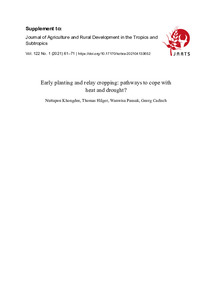Early planting and relay cropping: pathways to cope with heat and drought?
| dc.date.accessioned | 2021-05-06T14:37:12Z | |
| dc.date.available | 2021-05-06T14:37:12Z | |
| dc.date.issued | 2021-05-05 | |
| dc.identifier | doi:10.17170/kobra-202104133652 | |
| dc.identifier.uri | http://hdl.handle.net/123456789/12806 | |
| dc.language.iso | eng | eng |
| dc.rights | Namensnennung 4.0 International | * |
| dc.rights.uri | http://creativecommons.org/licenses/by/4.0/ | * |
| dc.subject | abiotic stress | eng |
| dc.subject | climate change | eng |
| dc.subject | erratic rainfall | eng |
| dc.subject | escape strategies | eng |
| dc.subject | Southeast Asia | eng |
| dc.subject.ddc | 630 | |
| dc.title | Early planting and relay cropping: pathways to cope with heat and drought? | eng |
| dc.type | Aufsatz | |
| dcterms.abstract | Maize (Zea mays) is an important food and cash crop of uplands in Southeast Asia, where it is often prone to drought and heat stress associated with climate change. This study aimed at assessing the effect of heat and drought on maize performance, testing coping strategies under such weather extremes, and understanding associated mechanisms. The experiment was carried out during 2018 in Thailand, using a split-plot design with three replications. Treatments were: July-planted maize sole cropping (control), July-planted maize-mungbean (Vigna radiata) relay cropping, and June-planted maize sole cropping. High temperatures and dry spells during July-August 2018 decreased maize growth strongest in the control and less so in maize relay cropping during generative growth stages, but not in June-planted maize sole cropping. Stress reduced maize nitrogen nutrition index by 40%. Relay-cropped maize had a significantly higher potential to keep stomata open (320 mmol m-2s-1) than sole-cropped maize (100 mmol m-2 s-1). Δ13C of maize grains confirmed that June-planted maize (‑9.43‰) was less affected by dry spells and heat stress than July-planted sole cropped maize (‑10.23‰). Under relay cropping, the later showed less water stress (δ13C: ‑10.12‰) compared to sole cropping and a higher soil water use. Maize was better able to cope with heat and drought stress when relayed-cropped, although less compared to early-planting of maize. Hence, the tested coping strategies are able to mitigate heat and drought effects on maize growth, while improving food security and crop diversification when relay-cropped with mungbeans. | eng |
| dcterms.accessRights | open access | |
| dcterms.creator | Khongdee, Nuttapon | |
| dcterms.creator | Hilger, Thomas | |
| dcterms.creator | Pansak, Wanwisa | |
| dcterms.creator | Cadisch, Georg | |
| dc.subject.swd | Südostasien | ger |
| dc.subject.swd | Abiotischer Faktor | ger |
| dc.subject.swd | Klimaänderung | ger |
| dc.subject.swd | Niederschlag | ger |
| dc.subject.swd | Mais | ger |
| dc.type.version | publishedVersion | |
| dcterms.source.identifier | eissn:2363-6033 | |
| dcterms.source.issue | No. 1 | |
| dcterms.source.journal | Journal of Agriculture and Rural Development in the Tropics and Subtropics (JARTS) | eng |
| dcterms.source.pageinfo | 61-71 | |
| dcterms.source.volume | Vol. 122 | |
| kup.iskup | false |
Dateien zu dieser Ressource
Das Dokument erscheint in:
-
Vol 122, No 1 (2021) [13]



